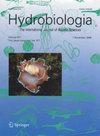拉布兰卡岛,墨西哥太平洋最东南的珊瑚礁群落
IF 0.3
4区 生物学
Q4 MARINE & FRESHWATER BIOLOGY
引用次数: 0
摘要
背景。东太平洋的珊瑚和珊瑚礁从加利福尼亚湾不连续地分布到墨西哥的华图尔科,从萨尔瓦多的Los Cóbanos到秘鲁北部。墨西哥太平洋最东南的珊瑚群落是Tejoncito (Huatulco海湾);然而,最近的调查将分布范围扩大到拉布兰卡岛。目标。了解与拉布兰卡岛珊瑚群落有关的特征、条件和动物群。方法。2016年,在La Blanca岛周围进行了调查,那里的北部有一个小珊瑚群落,但东部和西部都没有。结果。珊瑚群落位于大约3米深的地方,在一股强大的水流下;它很小,特点是珊瑚覆盖率相对较低(10%),品种有damicornis Pocillopora capitata和verrucosa Pocillopora。记录了3种珊瑚、13种棘皮动物和50种鱼类,这些物种通常与热带太平洋东部的珊瑚群落和珊瑚礁有关。La Blanca岛上珊瑚的存在是相关的,因为它对应于墨西哥太平洋最东南的记录(Tejoncito以东55公里,在Huatulco海湾地区);这一记录是惊人的,因为它位于一个上升流强、生产力高、水温变化剧烈、pH值和Ωarag值低的地区,所有这些都不利于幼虫的定居、珊瑚的生长和珊瑚群落的发展。结论。目前的记录不仅拓宽了墨西哥太平洋珊瑚和珊瑚群落的空间分布范围,而且为研究恶劣环境条件下造礁珊瑚的发展提供了机会。本文章由计算机程序翻译,如有差异,请以英文原文为准。
La Blanca Island, the southeasternmost coral reef community in the Mexican Pacific
Background. Corals and coral reefs of the eastern Pacific are distributed discontinuously from the Gulf of California to Huatulco, Mexico, and from Los Cóbanos, El Salvador, to northern Peru. The most southeastern coral community in the Mexican Pacific was Tejoncito (Huatulco Bays); however, recent surveys extend the distribution to La Blanca Island. Objective. To make known the characteristics, conditions, and fauna associated with the coral community of La Blanca Island. Methods. During 2016, surveys were conducted around La Blanca Island, where a small coral community was in the northern portion but not in the east and west. Results. The coral community is located at approximately 3 m depth and under a strong current; it is small and characterized by a relatively low coral cover (10 %) of the species Pocillopora damicornis, Pocillopora capitata, and Pocillopora verrucosa. Three coral species, 13 echinoderm species, and 50 fish species were recorded, all commonly associated with coral communities and reefs of the eastern tropical Pacific. The presence of corals on La Blanca Island is relevant because it corresponds to the most southeastern record in the Mexican Pacific (55 km East of Tejoncito, in the area of Huatulco Bays); the record is striking because it is located in a region with strong upwelling, high productivity, drastic changes in water temperature and low pH and Ωarag values, all of which are not very favorable for larval settlement, coral growth, and the development of coral communities. Conclusions. The current record not only broadens the spatial distribution range of corals and coral communities in the Mexican Pacific but also represents an opportunity to study the development of reef-building corals under harsh environmental conditions.
求助全文
通过发布文献求助,成功后即可免费获取论文全文。
去求助
来源期刊

Hidrobiologica
生物-海洋与淡水生物学
CiteScore
0.40
自引率
0.00%
发文量
8
审稿时长
>12 weeks
期刊介绍:
HIDROBIOLÓGICA es una publicación cuatrimestral que difunde trabajos originales e inéditos de investigación o revisión, sobre temas relacionados con los organismos y la hidrología de los ambientes acuáticos, dulces y marinos y va dirigida a investigadores de todo el mundo, interesados en las diversas disciplinas que incluye la Hidrobiología , así como a alumnos de posgrados y licenciaturas relacionados con la biología, ecología, taxonomía, filogenia y evolución de organismos acuáticos, e hidrología y oceanografía de ambientes s dulceacuícolas y marinos.
 求助内容:
求助内容: 应助结果提醒方式:
应助结果提醒方式:


